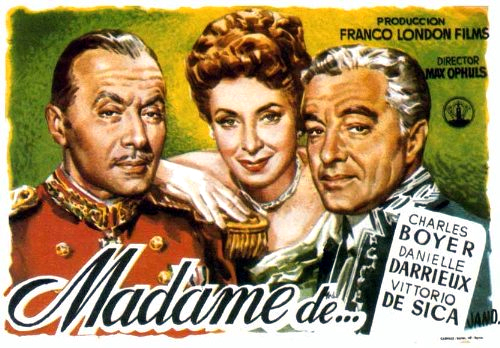|

(1953, directed by Max Ophüls)
- inducted 2017 –
“Someone once said of Max Ophuls that the mere mention of his name makes all cameras stand rigidly to attention. Never
was it more evident than here in this wonderfully cynical yet romantic eulogy to the very idea of romance and, indeed, truth.
Its protagonists belong to an altogether more civilized era, but an era no less open to falsehood and deceit. ‘I lie
so badly,’ the heroine tells her husband, but both we and the husband know the opposite is true. Yet he doesn’t
mind, the reason being that he is equally adept at deceit. It also seems to have a plot determined almost by predestination.
In La Ronde, we saw love itself go on a merry go round: in Madame de… it’s a token of love, but
the idea remains the same.
“Louise, whose surname we never find out (hence the title) is a Countess who has spent too much and needs to sell something
to pay off her debts. She decides to sell the diamond heart earrings given to her by her husband when they married and takes
them to the very same jeweler who sold them to her spouse, a general. However, when she fabricates losing them at the opera,
the husband thinks they’ve been stolen. The jeweler then explains the situation, but the husband does not return them
to his wife, instead going along with her innocent charade. He instead gives them to his mistress, who is leaving to start
a new life in Constantinople. However, down on her luck, she loses them over the roulette table and they come into the possession
of an Italian baron, who soon after falls in love with a French countess, none other than Louise…”
“Not since Dumas’ Anne of Austria gave Buckingham her twelve diamond studs has a token of jeweled affection led
to such intricate drama. It’s also quite a modern tale, with its wife in debt certainly paralleling those contemporary
stories of people going mad with credit cards. But Ophuls’ women are altogether more genteel, if also knowing their
weaknesses. ‘A woman can refuse jewelry before she has seen it; after, it takes heroism,” the departing de Léa
murmurs. His heroines, as the opening caption states, ‘seemed destined for a delightful, untroubled existence,’
and are draped in the most unimaginable finery, relics of a bygone era, born to waltz along to the immortal waltzes of Oscar
Straus. Even the finery is lingered over in a slow opening pan along Louise’s wardrobe.
“Of course, Ophuls’ technicians contribute perfectly to the tone of the film, with Matras’ camerawork and
d’Eaubonne’s decors as exemplary as one might expect. Van Parys’ music likewise perfectly depicts the whirls
of romantic emotion felt by the characters, and into which Straus’ waltz fits so seamlessly. As for the cast, how can
they be topped? Darrieux, still gorgeous sixteen years after starring at eighteen in Club de Femmes and Mayerling,
radiating eternal mystery and ageless beauty, paired once again with her co-star in the latter film, Boyer. Here was a man
who could never be less than debonair, always charming and a consistent joy to watch. Yet the real star here is not human,
but Ophuls’ camera, whether slowly panning along station platforms or whirling giddily and dextrously though a crowded
ballroom. Its speed dictates the rhythms of the film and the emotions of the protagonists. At times, we’re almost breathless
to
keep up with his toy, but are carried along by its almost Wildean plot to the last.”
~ Sam Juliano
|
|
Original title: Madame De…
Principal cast: Charles Boyer, Danielle Darrieux, Vittorio De Sica, Jean Debucourt, Jean Galland, Mireille Perry, Paul Azaïs,
Josselin, Hubert Noël, Lia Di Leo
Screenplay by Marcel Achard & Max Ophüuls & Annette Wademant
Dialogue by Marcel Achard
Based on the novel by Louise de Vilmorin
Cinematography by Christian Matras
Production design by Jean d’Eaubonne
Costume design by Georges Annenkov, Rosine Delamare
Film editing by Borys Lewin
Original music by Oscar Straus, Georges Van Parys
Makeup artist: Carmen Brel
Sound by Antoine Petitjean
Produced by Ralph Baum (uncredited)
France/Italy
Duration: 105 minutes
Languages: French
Filmed in black and white
Sound mix: Mono (Western Electric Sound System)
Aspect ratio: 1.37:1
Produced by Franco London Films, Indusfilms, Rizzoli Film
Released in USA by Arlan Productions
Premiered in France on 16 September 1953
USA release date: 19 July 1954
Awards and honors:
- Selected as one of Roger Ebert’s “Great Movies,” 11 November 2001
- Academy Awards (USA), 1954: Best Costume Design, Black and White (nominated)
|
 |
|
|
 |
|
|
 |
|
|
|

